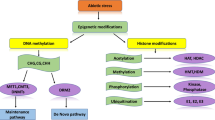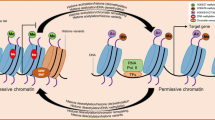Abstract
A 318 bp mannopine synthase 2′ (mas2′) promoter element from the T-DNA of Agrobacterium tumefaciens can direct wound-inducible and root-preferential expression of a linked uidA gene in transgenic tobacco plants. Wound inducibility is further enhanced by sucrose in the medium. Promoter deletion analysis indicated that the sucrose enhancement is conferred by a region extending from −318 to −213. DNase I footprinting indicated that an A/T-rich DNA sequence in this region is protected by tobacco nuclear factors. Regions extending from −103 to +66 and from −213 to −138 directed wound-inducibile expression of a linked uidA gene when placed downstream of a CaMV 35S enhancer or upstream of a truncated (−209) CaMV 35S promoter, respectively. DNase I footprinting analyses indicated that proteins from wounded tobacco leaves specifically bound to three contiguous motifs downstream of the mas2′ TATA box. In addition to a common retarded band formed by the upstream wound-responsive element complexed with proteins from either wounded or unwounded tobacco leaves, two unique retarded bands were observed when this element was incubated with protein from wounded leaves. Methylation interference analysis additionally identified an unique motif composed of promoter elements and nuclear factors derived specifically from wounded tobacco leaves. We propose a model to describe the involvement of nuclear factors with mas2′ promoter elements in wound-inducible gene expression.
Similar content being viewed by others
References
An G, Costa MA, Ha S-B: Nopaline synthase promoter is wound inducible and auxin inducible. Plant Cell 2: 225–233 (1990).
Barker RF, Idler KB, Thompson DV, Kemp JD: Nucleotide sequence of the T-DNA region from the Agrobacterium tumefaciens octopine Ti-plasmid pTi15955. Plant Mol Biol 2: 335–350 (1983).
Bellmann R, Werr W: Zmhoxla, the product of a novel maize homeobox gene, interacts with the shrunken feed-back 26 bp control element. EMBO J 11: 3367–3374 (1992).
Benfey PN, Ren L, Chua N-H: The CaMV 35S enhancer contains at least two domains which can confer different developmental and tissue-specific expression patterns. EMBO J 8: 2195–2202 (1989).
Bevan M, Barker R, Goldsbrough A, Jarvis M, Kavanagh T, Iturriaga G: The structure and transcription start site of a major potato tuber protein gene. Nucl Acids Res 14: 4625–4638 (1986).
Bouchez D, Tokuhisa JG, Llewellyn DJ, Dennis ES, Ellis JG: The ocs-element is a component of the promoters of several T-DNA and plant viral genes. EMBO J 8: 4197–4204 (1989).
Comai L, Moran P, Maslyar D: Novel and useful properties of a chimeric plant promoter combining CaMV 35S and MAS elements. Plant Mol Biol 15: 373–381 (1990).
de Vries S, Hoge H, Bisseling T: Isolation of total and polysomal RNA from plant tissues. In: Gelvin SB, Schilperoort RA (eds) Plant Molecular Biology Manual, pp. B6/1-B6/13. Kluwer Academic Publishers, Dordrecht, Netherlands, (1992).
DiRita VJ, Gelvin SB: Deletion analysis of the mannopine synthase gene promoter in sunflower crown gall tumors and Agrobacterium tumefaciens. Mol Gen Genet 207: 233–241 (1987).
Ditta G, Stanfield S, Corbin D, Helinski DR: Broad host range cloning system for Gram-negative bacteria: Construction of a gene bank of Rhizobium meliloti. Proc Natl Acad Sci USA 77: 7347–7351 (1980).
Dynan WS: Modularity in promoters and enhancers. Cell 58: 1–4 (1989).
Ellis JG, Ryder MH, Tate ME: Agrobacterium tumefaciens TR-DNA encodes a pathway for agropine synthesis. Mol Gen Genet 195: 466–473 (1984).
Figurski DH, Helinski DR: Replication of an origincontaining derivative of plasmid RK2 dependent on a plasmid function provided in trans. Proc Natl Acad Sci USA 76: 1648–1652 (1979).
Fox PC, Vasil V, Vasil IK, Gurley WB: Multiple ocs-like elements required for efficient transcription of the mannopine synthase gene of T-DNA in maize protoplasts. Plant Mol Biol 20: 219–233 (1992).
Gelvin SB: Crown gall disease and hairy root diesease: a sledgehammer and a tackhammer. Plant Physiol 92: 281–285 (1990).
Gelvin SB: Chemical signaling between Agrobacterium and its plant host. In: DPS Verma (ed) Molecular Signals in Plant-Microbe Communications, pp. 137–167. CRC Press, Boca Raton (1992).
Green PJ, Kay SA, Lam E, Chua N-H: In vitro DNA footprinting. In: Gelvin SB, Schilperoort RA (eds) Plant Molecular Biology Manual, pp. B11/1-B11/22. Kluwer Academic Publishers, Dordrecht, Netherlands (1989).
Green PJ, Kay SA, Chua N-H: Sequence-specific interactions of a pea nuclear factor with light-responsive elements upstream of the rbcS-3A gene. EMBO J 6: 2543–2549 (1987).
Guevara-Garcia A, Mosqueda-Cano G, Arguello-Astorga G, Simpson J, Herrera-Estrella L: Tissue-specific and wound-inducible pattern of expression of the mannopine synthase promoter is determined by the interactions between positive and negative cis-regulatory elements. Plant J 4: 495–505 (1993).
Hattori T, Nakagawa S, Nakamura K: High-level expression of tuberous root storage protein genes of sweet potato in stems of plantlets grown in vitro on sucrose medium. Plant Mol Biol 14: 595–604 (1990).
Hoekema A, Hirsch PR, Hooykaas PJJ, Schilperoort RA: A binary plant vector strategy based on separation of vir- and T-region of the Agrobacterium tumefaciens Ti-plasmid. Nature 303: 179–180 (1983).
Horsch RB, Fry JE, Hoffmann NL, Eichholtz D, Rogers SG, Fraley RT: A simple and general method for transferring genes into plants. Science 227: 1229–1231 (1985).
Jefferson RA, Wilson KJ: The GUS gene fusion system. In: Gelvin SB, Schilperoort RA (eds) Plant Molecular Biology Manual, pp. B14/1-B14/33, Kluwer Academic Publishers, Dordrecht, Netherlands (1991).
Katagiri F, Lam E, and Chua N-H: Two tobacco DNA-binding proteins with homology to the nuclear factor CREB. Nature 340: 727–730 (1989).
Kim S-R, Costa MA, An G Sugar response element enhances wound response of potato proteinase inhibitor II promoter in transgenic tobacco. Plant Mol Biol 17: 973–983 (1991).
Komro CT, DiRita VJ, Gelvin SB, Kemp JD: Site-specific mutagenesis in the TR-DNA region of octopine-type Ti plasmids. Plant Mol Biol 4: 253–263 (1985).
Lam E, Benfey PN, Gilmartin PM, Fang R-X, Chua N-H Site-specific mutations alter in vitro factor binding and change promoter expression pattern in transgenic plants. Proc Natl Acad Sci USA 86: 7890–7894 (1989).
Langridge WHR, Fitzgerald KJ, Koncz C, Schell J, Szalay AA: Dual promoter of Agrobacterium tumefaciens mannopine synthase genes is regulated by plant growth hormones. Proc Natl Acad Sci USA 86: 3219–3223 (1989).
Lee JS, Brown WE, Graham JS, Pearce G, Fox EA, Dreher TW, Ahern KG, Pearson GD, Ryan CA: Molecular characterization and phylogenetic studies of a wound-inducible proteinase inhibitor I gene in Lycopersicon species. Proc Natl Acad Sci USA 83: 7277–7281 (1986).
Leisner SM, Gelvin SB: Structure of the octopine synthase upstream activator sequence. Proc Natl Acad Sci USA 85: 2553–2557 (1988).
Leung J, Fukuda H, Wing D, Schell J, Masterson R: Functional analysis of cis-elements, auxin response, and early developmental profiles of the mannopine synthase bidirectional promoter. Mol Gen Genet 230: 463–474 (1991).
Lichtenstein C, Draper J: Genetic engineering of plants. In: Glover DM (ed) DNA Cloning: A Practical Approach, vol. 2, pp. 67–119. IRL Press, Washington, DC (1986).
Linthorst HJM, Brederode FT, van der Does C, Bol JF: Tobacco proteinase inhibitor I genes are locally, but not systemically induced by stress. Plant Mol Biol 21: 985–992 (1993).
Maniatis T, Fritsch EF, Sambrook J: Molecular Cloning: A Laboratory Manual, Cold Spring Harbor Laboratory, Cold Spring Harbor, NY (1982).
Mason HS, DeWald DB, Mullet JE Identification of a methyl jasmonate-responsive domain in the soybean vspB promoter. Plant Cell 5: 241–251 (1993).
Ni M, Cui D, Einstein J, Narasimhulu S, Vergara CE, Gelvin SB: Strength and tissue specificity of chimaeric promoters derived from the octopine and mannopine synthase genes. Plant J 7: 661–676 (1995).
Palm CJ, Costa MA, An G, Ryan CA: Wound-inducible nuclear protein binds DNA fragments that regulate a proteinase inhibitor II gene from potato. Proc. Natl. Acad Sci USA 87: 603–607 (1990).
Patterson GL: A simplification of the protein assay method of Lowry et al. which is more generally applicable. Anal Biochem 83: 346–356 (1977).
Saito K, Yamazaki M, Kaneko H, Murakoshi I, Fukuda Y, Van Montagu M: Tissue-specific and stress-enhancing expression of the TR promoter for mannopine synthase in transgenic medicinal plants. Planta 184: 40–46 (1991).
Sarokin LP, Chua N-H: Binding sites for two novel phosphoproteins, 3AF5 and 3AF3, are required for rbcS-3A expression. Plant Cell 4: 473–483 (1992).
Singh K, Dennis ES, Ellis JG, Llewellyn DJ, Tokuhisa JG, Wahleithner JA, Peacock WJ: OCSBF-1, a maize Ocs enhancer binding factor: Isolation and expression during development. Plant Cell 2: 891–903 (1990).
Sobczyk A, Schvns G, Tandeau de Marsac N, Houmard J: Transduction of the light signal during complementary chromatic adaptation in the cyanobacterium Calothrix sp. PCC 7601: DNA-binding proteins and modulation by phosphorylation. EMBO J 12: 997–1004 (1993).
Sun L, Doxsee RA, Harel E, Tobin EM: CA-1, a novel phosphoprotein, interacts with the promoter of the cab140 gene in Arabidopsis and is undetectable in det1 mutant seedlings. Plant Cell 5: 109–121 (1993).
Teeri TH, Lehvaslaiho H, Frank M, Uotila J, Heino P, Palva ET, Van Montagu M. Herrera-Estrella L: Gene fusions to lacZ reveal new expression patterns of chimeric genes in transgenic plants. EMBO J 8: 343–350 (1989).
Thornburg RW. An G, Cleveland TE, Johnson R, Ryan CA: Wound-inducible expression of a potato inhibitor II-chloramphenicol transferase gene fusion in transgenic tobacco plants. Proc Natl Acad Sci USA 84: 744–748 (1987).
Ursin VM, Shewmaker CK: Demonstration of a senescence component in the regulation of the mannopine synthase promoter. Plant Physiol 102: 1033–1036 (1993).
Velton J, Velten L, Hain R, Schell J: Isolation of a dual plant promoter fragment from the Ti plasmid of Agrobacterium tumefaciens. EMBO J 3: 2723–2730 (1984).
Weiss C, Bevan M: Ethylene and a wound signal modulate local and systemic transcription of win2 gene in transgenic potato plants. Plant Physiol 96: 943–951 (1991).
Yamamoto KK, Gonzaiez GA, Biggs WH, Monyminy MR: Phosphorylation-induced binding and transcriptional efficacy of nuclear factor CREB. Nature 334: 494–498 (1988).
Zambryski PC: Chronicles from the Agrobacterium-plant cell DNA transfer story. Annu Rev Plant Physiol Plant Mol Biol 43: 465–490 (1982).
Author information
Authors and Affiliations
Rights and permissions
About this article
Cite this article
Ni, M., Cui, D. & Gelvin, S.B. Sequence-specific interactions of wound-inducible nuclear factors with mannopine synthase 2′ promoter wound-responsive elements. Plant Mol Biol 30, 77–96 (1996). https://doi.org/10.1007/BF00017804
Received:
Accepted:
Issue Date:
DOI: https://doi.org/10.1007/BF00017804




